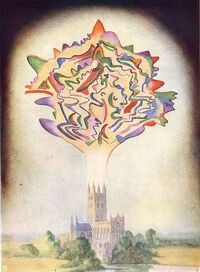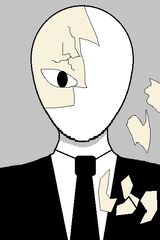Many blogs, canons, and verses have their own theory of where the Fears came from. This page makes an attempt to list all of the theories that occur in the mythos.
Omnipotence Theory[]
The Omnipotence Theory is simple. It states the Fears have always existed. They may change forms or not yet be tangible, but they were always there. Their "births" are merely them making their first appearance after deciding on a form or finally meeting the requirements needed to manifest in a physical form.
The Tulpa Effect[]

Thought-form of the Music of Gounod in Thought Forms (1901).
The Tulpa Effect is an idea, originating from Tibetan mythology, which holds that an individual thinking hard enough about a single idea or concept can create something. This is expanded upon within The Fear Mythos to include the idea that collective thought can create beings out of idea-concepts. As an example, think of what Peter Pan says about fairies. Every time someone stops believing in fairies, one of them dies. This suggests that the fairies' existence is based upon people's belief in them. Thus, if no one believed in fairies, they would cease to exist. In a similar sense, some stories assume that The Fears exist because people believe in them. Some stories use this to justify the existence of The Compulsion as well, as it could help the Fears find more people to believe in them and keep their existence in check. However, The Fears do not need a large number of people to believe in them, and will continue to exist so long as someone in the world still believes in them.
Tulpas, as mentioned above, originate from Tibetan Buddhism, although there is a Western equivalent known as "thoughtform." Within Tibetan Buddhism, Tulpas are bodies created from one person's mind, usually as a form of extra body, which the person then uses to travel to spiritual realms.
Fear Embodiment Theory[]
The Fear Embodiment Theory says that The Fears are created through humanity's collective fear of a particular thing or concept. However, unlike The Tulpa Effect, Fear Embodiment Theory does not require anyone to have a concept or awareness of an embodiment of that phobia. Thus, through this theory, a Fear could exist without anyone knowing it exists, so long as the concept it embodies is feared by a significant amount of people. For example, The Quiet has likely always existed because the fear of vanishing into nothingness and/or nameless obscurity is a deeply rooted fear within most humans.
The Runner Verse takes this theory a step further, claiming that Fears are only as powerful as how feared their represented subject is, and it is possible for a Fear to lose their status as a Fear, creating Fallen Fears.
Meme Complex[]
See alliterator's explanation here.
In order to understand Meme Complex Theory, one must first understand what a meme is. Originally coined by ethologist and evolutionary biologist Richard Dawkins in his book The Selfish Gene, a meme is an idea, behavior, or trend that spreads from person to person within a culture. In other words, the theory of memes proposes that information can replicate itself via cultural means in a manner analogous to how genes propagate in biology. A meme can be transmitted from one mind to another by many means, including writing, speech, gestures, rituals, or other imitable phenomena. Furthermore, because humans do not always copy memes perfectly, and may refine, combine or otherwise modify them with other memes to create new memes, they can change over time.
Another major idea in memetics is the idea of meme complexes or memeplexs, which is a series of memes that group together within the same individual. Dawkins used the example of organized religion: "Perhaps we could regard an organized church, with its architecture, rituals, laws, music, art, and written tradition, as a co-adapted stable set of mutually-assisting memes." Using this definition, Meme Complex Theory suggests that The Fears are in fact meme complexes or, as some bloggers put it, "memetic monsters". The Slender Man for example is a meme that struck a chord with many people when it first appeared on the SomethingAwful forum, which led to some users to imitate and replicate it. During this process other details about the Slender Man began to attach themselves to the meme: facelessness, forests, child abduction, cryptic symbols, distortion, sickness, Proxies, etc. All of these things became memes and attached themselves to the Slender Man creating a meme complex.
The Panopticon is a group that believes in Meme Complex Theory, and wish to eradicate The Fears. Initially they were a government think tank that looked into the phenomena of "runners" and "proxies" until they actually caught a glimpse of the Slender Man. They convinced themselves that Slender Man was a meme complex so powerful that just having it in your head caused you to hallucinate him. They sought to eliminate the "Slender Man meme complex" by brainwashing those who believed in it into disbelieving in the meme, removing the meme complex from their head. To this end, they used another meme and tried to instill it into people's minds: "This is the best of all possible worlds." Whether the Panopticon is right or wrong is purely up to the author in question. In their first appearance Don't Let Them Tell Us Stories, the Panopticon is decidedly wrong and their methods are harmful.
Eldritch Ascension[]

Drawn by PyroGothNerd
Eldritch Ascension Theory claims that every Fear came from something decidedly more mortal. Stories that adhere to Eldritch Ascension might give every Fear a human backstory before something causes them to ascend into the Godlike beings, which are often expected in Fearblogs. Some stories may give a majority of the Fears a mortal backstory, but leave others open to interpretation to provide mystery.
This theory can be traced back to Hidden in the Trees, where The Wooden Girl took new vessels in human bodies to avoid being killed. The concept was later codified by The Harlequin in OH GOD THE RAPTURE IS BURNING, a former Proxy of the Slender Man who believed she was in love with him when in reality he was abusing and manipulating her. One day, she caught on to what was really happening, so The Ecclesiarchway granted her eldritch powers, allowing her to confront her abuser only to slip back into the cycle of abuse, which is the concept she represents as a Fear.
In some stories, the events that lead to a human's ascension to Godhood correlates to what they will represent as a Fear. For example, some versions of The Constant Wanderer were subjected to a cycle of death and rebirth that transformed them into a Fear representing repetition, routine, and leading a meaningless existence.
This theory can be traced outside of the mythos to such things as superhero comics, where every superhero and supervillain have an often-tragic backstory, or the Roman poem Metamorphoses where Salmacis rapes Hermaphroditus and thus forces him to merge with her, becoming a higher being by proxy.
Artificial Creation[]
The Artificial Creation Theory is the theory that someone, or something, created the Fears. The beings or group responsible for this tends to vary from verse to verse, due to varying interpretations of certain beings.
In The Somniverse, The Fears were created by Jack of All to be a more active force to enact his plans so he could, for the most part, lay back and enjoy. Each one was created from twisted mortal desires (e.g. a man wanted to see his dead lover again so he made him the afterlife). Despite some of them only being created as early as 2011, they were made to have existed retroactively since the dawn of time. They all fear Jack because they know him as their creator and a being above them, but they fear nothing else. They serve him somewhat unwillingly, as their own desires and decisions work far better than any commands Jack could ever give them.
Break-Off Theory[]
The Break-Off Theory is the idea that The Fears were originally part of one being, but then split off. This "original being" can be an all powerful being that once existed, or other Fears.
For example: In the Runner Verse, The Eye was originally one of Transgression's eyes. Also, some stories speculate that The Burning Bride and The Brute may have been one being at some point.
A variant of this theory is that the Fears are all extensions of one being, similar to how Dying Man Shards are extensions of The Dying Man or how some Servants seem to be extensions of their masters.
Multiple Source Theories[]
Multiple Source Theories incorporate two or more of the already mentioned theories, usually to provide multiple ways a Fear can be created.
For example: The Runner Verse uses Break-Off Theory to explain the creation of Mister Oculus, and Eldritch Ascention Theory to explain Transgression and Wooden Girl. It also uses Fear Embodiment Theory to explain one of the many ways a Fear could become a Fallen Fear through loss of power.
